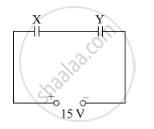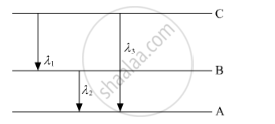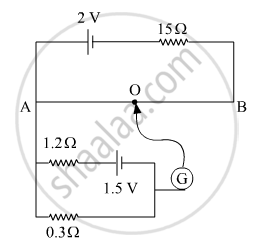Commerce (English Medium)
Science (English Medium)
Arts (English Medium)
Academic Year: 2015-2016
Date & Time: 5th March 2016, 10:30 am
Duration: 3h
Advertisements
Write the underlying principle of a moving coil galvanometer.
Chapter: [0.04] Moving Charges and Magnetism
Why are microwaves considered suitable for radar systems used in aircraft navigation?
Chapter: [0.08] Electromagnetic Waves
Define 'quality factor' of resonance in a series LCR circuit. What is its SI unit?
Chapter: [0.07] Alternating Current
A point charge +Q is placed at point O, as shown in the figure. Is the potential difference VA – VB positive, negative or zero?

Chapter: [0.02] Electrostatic Potential and Capacitance
How does the electric flux due to a point charge enclosed by a spherical Gaussian surface get affected when its radius is increased?
Chapter: [0.01] Electric Charges and Fields
A nucleus with mass number A = 240 and BE/A = 7.6 MeV breaks into two fragments, each of A = 120 with BE/A = 8.5 MeV. Calculate the released energy.
Chapter: [0.13] Nuclei
Calculate the energy in fusion reaction:
`""_1^2H+_1^2H->_2^3He+n`, where BE of `""_1^2H`23He=7.73MeV" data-mce-style="position: relative;">=2.2323He=7.73MeV MeV and of `""_2^3He=7.73 MeV`
Chapter: [0.13] Nuclei
Two cells of emfs 1.5 V and 2.0 V, having internal resistances 0.2 Ω and 0.3 Ω, respectively, are connected in parallel. Calculate the emf and internal resistance of the equivalent cell.
Chapter: [0.03] Current Electricity
The value of Brewster's angle for a transparent medium is different for light of different colours. Give reason.
Chapter: [0.1] Wave Optics
Explain the terms Attenuation used in Communication System.
Chapter: [0.15] Communication Systems
Explain the terms Demodulation used in Communication System.
Chapter: [0.15] Communication Systems
Plot a graph showing variation of de Broglie wavelength λ versus `1/sqrtV` , where V is accelerating potential for two particles A and B, carrying the same charge but different masses m1, m2 (m1 > m2). Which one of the two represents a particle of smaller mass and why?
Chapter: [0.11] Dual Nature of Radiation and Matter
Advertisements
Define mutual inductance.
Chapter: [0.06] Electromagnetic Induction
A pair of adjacent coils has a mutual inductance of 1.5 H. If the current in one coil changes from 0 to 20 A in 0.5 s, what is the change of flux linkage with the other coil?
Chapter: [0.06] Electromagnetic Induction
Two parallel-plate capacitors X and Y have the same area of plates and same separation between them. X has air between the plates, while Y contains a dielectric medium of εr = 4.

(i) Calculate capacitance of each capacitor if the equivalent capacitance of the combination is 4 μF.
(ii) Calculate the potential difference between the plates X and Y.
(iii) Estimate the ratio of electrostatic energies stored in X and Y.
Chapter: [0.02] Electrostatic Potential and Capacitance
Two long, straight, parallel conductors carry steady currents, I1 and I2, separated by a distance d. If the currents are flowing in the same direction, show how the magnetic field set up in one produces an attractive force on the other? Obtain the expression for this force. Hence, define one ampere.
Chapter: [0.04] Moving Charges and Magnetism
A charge is distributed uniformly over a ring of radius 'a'. Obtain an expression for the electric intensity E at a point on the axis of the ring. Hence, show that for points at large distance from the ring, it behaves like a point charge.
Chapter: [0.01] Electric Charges and Fields
Write three characteristic features in photoelectric effect that cannot be explained on the basis of wave theory of light, but can be explained only using Einstein's equation.
Chapter: [0.11] Dual Nature of Radiation and Matter
(a) Write the expression for the magnetic force acting on a charged particle moving with velocity v in the presence of magnetic field B.
Chapter: [0.04] Moving Charges and Magnetism
A neutron, an electron and an alpha particle, moving with equal velocities, enter a uniform magnetic field going into the plane of the paper, as shown. Trace their paths in the field and justify your answer.

Chapter: [0.04] Moving Charges and Magnetism
Calculate the distance of an object of height h from a concave mirror of radius of curvature 20 cm, so as to obtain a real image of magnification 2. Find the location of the image also.
Chapter: [0.09] Ray Optics and Optical Instruments
Using mirror formula, explain why does a convex mirror always produce a virtual image.
Chapter: [0.09] Ray Optics and Optical Instruments
(i) State Bohr's quantization condition for defining stationary orbits. How does the de Broglie hypothesis explain the stationary orbits?
(ii) Find the relation between three wavelengths λ1, λ2 and λ3 from the energy-level diagram shown below.

Chapter: [0.12] Atoms
Draw a schematic ray diagram of a reflecting telescope showing how rays coming from a distant object are received at the eyepiece.
Chapter: [0.09] Ray Optics and Optical Instruments
Write two important advantages of reflecting telescope over a refracting telescope.
Chapter: [0.09] Ray Optics and Optical Instruments
How are em waves produced by oscillating charges?
Chapter: [0.08] Electromagnetic Waves
Draw a sketch of linearly polarized em waves propagating in the Z-direction. Indicate the directions of the oscillating electric and magnetic fields.
Chapter: [0.08] Electromagnetic Waves
Write Maxwell's generalization of Ampere's circuital law. Show that in the process of charging a capacitor, the current produced within the plates of the capacitor is `I=varepsilon_0 (dphi_E)/dt,`where ΦE is the electric flux produced during charging of the capacitor plates.
Chapter: [0.04] Moving Charges and Magnetism
Advertisements
Explain any two factors that justify the need of modulating a low-frequency signal.
Chapter: [0.15] Communication Systems
Write two advantages of frequency modulation over amplitude modulation.
Chapter: [0.15] Communication Systems
Write the functions of three segments of a transistor.
Chapter: [0.14] Semiconductor Electronics - Materials, Devices and Simple Circuits
Meeta's father was driving her to school. At the traffic signal, she noticed that each traffic light was made of many tiny lights instead of a single bulb. When Meeta asked this question to her father, he explained the reason for this.
Answer the following questions based on above information:
(i) What were the values displayed by Meeta and her father?
(ii) What answer did Meeta's father give?
(iii) What are the tiny lights in traffic signals called and how do these operate?
Chapter: [0.14] Semiconductor Electronics - Materials, Devices and Simple Circuits
Define the term drift velocity.
Chapter: [0.03] Current Electricity
On the basis of electron drift, derive an expression for resistivity of a conductor in terms of number density of free electrons and relaxation time. On what factors does resistivity of a conductor depend?
Chapter: [0.03] Current Electricity
Why alloys like constantan and manganin are used for making standard resistors?
Chapter: [0.03] Current Electricity
State the principle of working of a potentiometer.
Chapter: [0.03] Current Electricity
In the following potentiometer circuit, AB is a uniform wire of length 1 m and resistance 10 Ω. Calculate the potential gradient along the wire and balance length AO (= l).

Chapter: [0.03] Current Electricity
An a.c. source of voltage V = V0 sin ωt is connected to a series combination of L, C, and R. Use the phasor diagram to obtain the expression for an impedance of a circuit and the phase angle between voltage and current. Find the condition when current will be in phase with the voltage. What is the circuit in this condition called?
Chapter: [0.07] Alternating Current
In a series LR circuit, XL = R and power factor of the circuit is P1. When capacitor with capacitance C such that XL = XC is put in series, the power factor becomes P2. Calculate P1/P2
Chapter: [0.07] Alternating Current
Write the function of a transformer.
Chapter: [0.07] Alternating Current
State the principle of transformer working with the help of a diagram
Chapter: [0.07] Alternating Current
Mention various energy losses in transformer device
Chapter: [0.07] Alternating Current
The primary coil of an ideal step-up transformer has 100 turns and the transformation ratio is also 100. The input voltage and power are 220 V and 1100 W, respectively. Calculate the
(a) number of turns in secondary
(b) current in the primary
(c) a voltage across secondary
(d) current in secondary
(e) power in secondary
Chapter: [0.07] Alternating Current
(i) In Young's double-slit experiment, deduce the condition for (a) constructive and (b) destructive interferences at a point on the screen. Draw a graph showing variation of intensity in the interference pattern against position 'x' on the screen.
(b) Compare the interference pattern observed in Young's double-slit experiment with single-slit diffraction pattern, pointing out three distinguishing features.
Chapter: [0.1] Wave Optics
Plot a graph to show the variation of the angle of deviation as a function of the angle of incidence for light passing through a prism. Derive an expression for the refractive index of the prism in terms of angle of minimum deviation and angle of the prism.
Chapter: [0.09] Ray Optics and Optical Instruments
What is a dispersion of light
Chapter: [0.09] Ray Optics and Optical Instruments
What is the cause of dispersion of light
Chapter: [0.09] Ray Optics and Optical Instruments
A ray of light incident normally on one face of a right isosceles prism is totally reflected, as shown in fig. What must be the minimum value of refractive index of glass? Give relevant calculations.

Chapter: [0.09] Ray Optics and Optical Instruments
Other Solutions
Submit Question Paper
Help us maintain new question papers on Shaalaa.com, so we can continue to help studentsonly jpg, png and pdf files
CBSE previous year question papers Class 12 Physics with solutions 2015 - 2016
Previous year Question paper for CBSE Class 12 Physics-2016 is solved by experts. Solved question papers gives you the chance to check yourself after your mock test.
By referring the question paper Solutions for Physics, you can scale your preparation level and work on your weak areas. It will also help the candidates in developing the time-management skills. Practice makes perfect, and there is no better way to practice than to attempt previous year question paper solutions of CBSE Class 12.
How CBSE Class 12 Question Paper solutions Help Students ?
• Question paper solutions for Physics will helps students to prepare for exam.
• Question paper with answer will boost students confidence in exam time and also give you an idea About the important questions and topics to be prepared for the board exam.
• For finding solution of question papers no need to refer so multiple sources like textbook or guides.
